| ________________
CM . . . . Volume XVIII Number 4 . . . . September 23, 2011

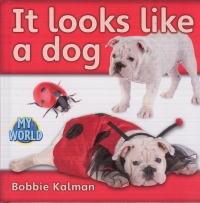 |
It Looks Like a Dog. (My World).
Bobbie Kalman.
St. Catharines, ON: Crabtree, 2011.
16 pp., pbk. & hc., $6.95 (pbk.), $15.16 (RLB.).
ISBN 978-0-7787-9571-1 (pbk.), ISBN 978-0-7787-9546-9 (RLB).
Subject Heading:
Dogs-Pictorial works-Juvenile literature.
Preschool-kindergarten / Ages 4-5.
Review by Carrie Subtelny.
*** /4
|
| |
|
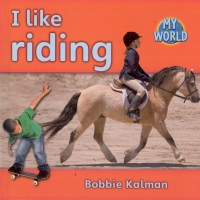 |
I Like Riding. (My World).
Bobbie Kalman.
St. Catharines, ON: Crabtree, 2011.
16 pp., pbk. & hc., $6.95 (pbk.), $15.16 (RLB.).
ISBN 978-0-7787-9575-9 (pbk.), ISBN 978-0-7787-9550-6 (RLB).
Subject Heading:
Vehicles-Juvenile literature.
Preschool-kindergarten / Ages 4-5.
Review by Carrie Subtelny.
*** /4
|
| |
|
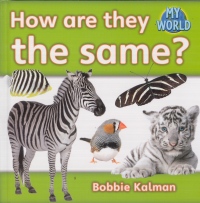 |
How Are They the Same? (My World).
Bobbie Kalman.
St. Catharines, ON: Crabtree, 2011.
16 pp., pbk. & hc., $6.95 (pbk.), $15.16 (RLB.).
ISBN 978-0-7787-9581-0 (pbk.), ISBN 978-0-7787-9556-8 (RLB).
Subject Headings:
Animals-Miscellanea-Juvenile literature.
Visual perception-Juvenile literature.
Grade 1 / Age 6.
Review by Carrie Subtelny.
*** /4 |
| |
|
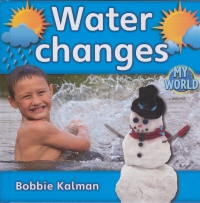 |
Water Changes. (My World).
Bobbie Kalman.
St. Catharines, ON: Crabtree, 2011.
16 pp., pbk. & hc., $6.95 (pbk.), $15.16 (RLB.).
ISBN 978-0-7787-9584-1 (pbk.), ISBN 978-0-7787-9559-9 (RLB).
Subject Headings:
Hydrologic cycle-Juvenile literature.
Water-Juvenile literature.
Grade 1 / Age 6.
Review by Carrie Subtelny.
*** /4 |
| |
|
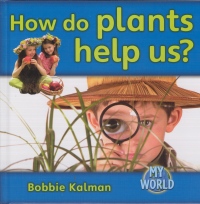 |
How Do Plants Help Us? (My World).
Bobbie Kalman.
St. Catharines, ON: Crabtree, 2011.
16 pp., pbk. & hc., $6.95 (pbk.), $15.16 (RLB.).
ISBN 978-0-7787-9586-5 (pbk.), ISBN 978-0-7787-9561-2 (RLB).
Subject Heading:
Plants-Juvenile literature.
Grade 1 / Age 6.
Review by Carrie Subtelny.
*** /4 |
| |
|
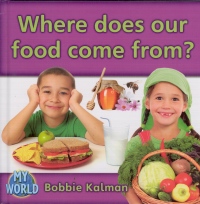 |
Where Does Our Food Come From? (My World).
Bobbie Kalman.
St. Catharines, ON: Crabtree, 2011.
24 pp., pbk. & hc., $7.95 (pbk.), $18.36 (RLB.).
ISBN 978-0-7787-9590-2 (pbk.), ISBN 978-0-7787-9565-0 (RLB).
Subject Headings:
Food-Juvenile literature.
Nutrition-Juvenile literature.
Grade 1 / Age 6.
Review by Carrie Subtelny.
*** /4 |
| |
|
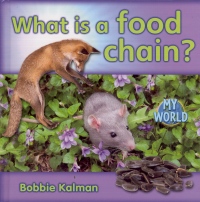 |
What is a Food Chain? (My World).
Bobbie Kalman.
St. Catharines, ON: Crabtree, 2011.
24 pp., pbk. & hc., $7.95 (pbk.), $18.36 (RLB.).
ISBN 978-0-7787-9592-6 (pbk.), ISBN 978-0-7787-9567-4 (RLB).
Subject Heading:
Food chains (Ecology)-Juvenile literature.
Grade 1 / Age 6.
Review by Carrie Subtelny.
*** /4 |
| |
|
| |
| |
|

Crabtree continues to publish the "My World" series, levelled texts by Bobbie Kalman. The Fountas and Pinnell levelling system is used as the guide for levelling this series. The source chosen for levelling is important to note as descriptive reading behaviours can vary in grade levels, depending on the system chosen. Because emergent readers use text to accelerate their early reading behaviours, it is integral that books/text match their stages of intended development. Text structures, text features, word repetition, grammar, vocabulary and amount of print per page are some of the considerations authors must pay attention to when crafting texts that intentionally consider "aspects of the reader" (Kibby, 1986)
The series “My World” was looked at for this review. Eight texts were issued – one at each Level, Levels A-H. Level A (pre-kindergarten/beginning kindergarten), Level B (mid kindergarten to beginning grade 1), Level C to Level H (beginning grade 1 - end of grade 1). It’s important to note the significant growth that takes place for a reader in grade 1. The growing understanding of “how books work” alongside the consolidation of sophisticated reading skills is remarkable. Thus, texts need to be designed with utmost consideration of the reader during this stage of learning. The following descriptors will give you an idea of what texts ‘look like’ at the B and G levels - what criteria are used.
For example, Level B books, according to the levelling criteria outlined by Fountas and Pinnell, should include some or most of the following: (1) 3-8 words per line (4-5 words on average); (2) one line per page, (3) 30-55 words in total, (4) complete sentences on each page, (5) repetition of high frequency words, (6) 2-3 high frequency words per page, (7) repetitive pattern that may change on the last page, (8) familiar topic, (9) predictable language, (10) consistent print placement. The criteria for Level G books can be described as having some or most of the following: (1) 2-12 words per line, (2) 2-7 lines per page, (3) 120-200 words in total, (4) complete sentences, (5) simple sentences with prepositional phrases and introductory clauses, (6) repetition of high frequency words, (7) predictable language and patterns, (8) illustration labels in non-fiction text, (9) simple tables and charts, (10) text features - table of contents, index, glossary, (11) high text/picture correspondence, (12) text placement can vary, (13) approximately 12 pages.
It Looks Like a Dog. (Level A)
Many children love animals and have pets that they take care of. However, I’m not sure if most pet-owners dress their dogs in costumes. Therefore, I would encourage a great deal of talk when introducing this book as some students may not understand why the dogs are being dressed up. The story, itself, is more about labelling: “It looks like a dog. Now the dog looks like a spider”. Although the text is a bit weak, Kalman provides pictures that are sharp and realistic. Vibrant colours are captured and depict clear images. When considering the criteria for texts at this level, there is a consistent repetitive pattern throughout with the pictures matching the text. However, the language structure, “Now the dog looks like my...” seems a bit sophisticated for pre K-K learner. The repetitive patterning does use common or high frequency words which is essential for students to build their bank of sight word vocabulary. Considering the support a reader needs at this stage of literacy development, teacher scaffolding will be needed to ensure voice-to-print match while reading, in addition to comprehension-conversations.
I Like Riding. (Level B)
This text seems to be a good match for the reader at this stage. Once again, photos are realistic and natural. There is good word patterning and predictability. Children have to watch the print near the end as the pattern changes from “I like riding...” to “I like flying....” The last two pages abandon the pattern altogether, an approach which encourages the reader to think about the story, look at the pictures and look at the print: “What would you like to ride?” (p.14). “Would you ride a huge grasshopper?” (p.15).
Farm Animals. (Level C)
This book has more than the required features to be considered a Level C text. The familiarity of the topic will be helpful for most children to decode and comprehend. However, the number of lines of print/page is not consistent, nor is text placement. Once again, the photos provide excellent picture support for readers. The last two pages of the text (page 14 and 15) include a matching game (“Talk like an animal! Which animal talks like this?”) and a goofy/gross picture of a cow licking his nostril! Kids will love imitating this photo and the prompt, “Can you touch your nose the way this cow can?”
How Are They the Same? (Level D)
This book about similarities and differences will invite students to notice and to use language to describe, compare and contrast. Kalman chooses to go beyond colour and size and invites readers to notice how certain animals are born (in an egg) and to find the word to describe this process (hatching). Once again, the pictures are crisp, real, and engaging.
Water Changes. (Level E)
This text is filled with great information about water. However, it’s ‘jam-packedness’ knocks it out of range for level E criteria. For example, the Reading A-Z website lists criteria for Level E texts (which correlates to the Fountas and Pinnell system), and the following is suggested: (1) repetitive pattern in middle with 2-4 word changes per page, (2) predictable language, (3) familiar topics, (4) high text/picture correspondence (see http://www.readinga-z.com/book/guided-reading.php?level=e for the entire list). Water Changes meets some of the criteria; however, a reader will require significant scaffolding to read this text with ease and enjoyment. Kalman does choose high-interest, nonfiction topics which students may be more motivated to dive into. In addition, nonfiction gives the reader choice – to choose which sections to focus on for information. Spending time with ‘chunks of text’ will be easier to navigate instead of reading a single topic from cover to cover.
How Do Plants Help Us? (Level F), Where Does Our Food Come From? (Level G), and What is a Food Chain? (Level H).
The books, How Do Plants Help Us? (Level F), Where Does Our Food Come From? (Level G) and What is a Food Chain? (Level H), will receive a similar review as that of Water Changes (Level E). Students will require support to manage all of the information present. Additionally, the texts at these levels should include the explicit terms used for text features – Table of Contents, Index (included in Levels G and H only), and Glossary. Kalman provides exceptional vocabulary lists and labels. The topics are consistently rich with information and the pictures are brilliant – vibrant and real. All of the texts mentioned in this review will invite many great conversations and deeper inquiry into topics of interest.
Looking at the eight books as a whole, each text provides a good foundation of information. When engaged in inquiry learning, students need exposure to multiple sources of information. These texts can provide an initial start to research. Some of the information is easy and interesting to follow and learn from while other facts will require further research. Comprehension conversations are critical to ensure accurate information is gathered from these sources. Students may need additional support to locate more information and to ask essential questions based on an inquiry focus.
Great photos are in all of the texts. I especially liked the picture of the plate of food in Where Does Our Food Come From? that represents each food group in addition to an appropriate portion size. This is a great visual to support all learners – emergent and beginning literacy learners and also EAL (English as an Additional Language).
Text features are consistently present (bold print, captions, labels, headings), but some could be made more noticeable. One suggestion is in regards to font size. The print in most of the captions could have been made smaller or in a different font so the reader can locate this information with greater ease. Children need explicit instruction in understanding text features, like captions and labels, when learning how to read and use nonfiction text, and thus it is important that these features are easy to locate in addition to what makes them different from the body of text.
Recommended.
Carrie Subtelny is an English Language Arts Consultant in Winnipeg, MB.

To comment
on this title or this review, send mail to cm@umanitoba.ca.
Copyright © the Manitoba Library Association. Reproduction for personal
use is permitted only if this copyright notice is maintained. Any
other reproduction is prohibited without permission.
NEXT REVIEW |
TABLE OF CONTENTS FOR THIS ISSUE
- September 16, 2011.
AUTHORS |
TITLES |
MEDIA REVIEWS |
PROFILES |
BACK ISSUES |
SEARCH |
CMARCHIVE |
HOME |






